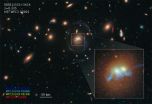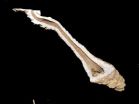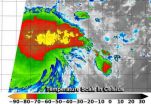(Press-News.org) NASA's Hubble Space Telescope has photographed an unusual structure 100,000 light years long, which resembles a corkscrew-shaped string of pearls and winds around the cores of two colliding galaxies.
The unique structure of the star spiral may yield new insights into the formation of stellar superclusters that result from merging galaxies and gas dynamics in this rarely seen process.
"We were surprised to find this stunning morphology. We've long known that the 'beads on a string' phenomenon is seen in the arms of spiral galaxies and in tidal bridges between interacting galaxies. However, this particular supercluster arrangement has never been seen before in giant merging elliptical galaxies," said Grant Tremblay of the European Southern Observatory in Garching, Germany.
Young, blue super star clusters are evenly spaced along the chain through the galaxies at separations of 3,000 light-years. The pair of elliptical galaxies is embedded deep inside the dense galaxy cluster known as SDSS J1531+3414. The cluster's powerful gravity warps the images of background galaxies into blue streaks and arcs that give the illusion of being inside the cluster, an effect known as gravitational lensing.
Observing astronomers first hypothesized that the "string of pearls" was actually a lensed image from one of these background galaxies, but their recent follow-up observations with the Nordic Optical Telescope in Santa Cruz de Tenerife, Spain, ruled out this hypothesis.
The galaxy cluster is part of a Hubble program to observe 23 massive clusters that create powerful gravitational lensing effects on the sky. The clusters were first cataloged in the Sloan Digital Sky Survey (SDSS), a project to create the most detailed three-dimensional maps ever made of the universe. Tremblay's team discovered the bizarre string of stellar superclusters by chance, while reviewing images as they came in from Hubble. Researchers were stunned by what they saw in SDSS J1531+3414, and the unique nature of the source spurred the team to do follow-up observations with both ground and space-based telescopes.
The underlying physical processes that give rise to the "string of pearls" structure are related to the Jeans instability, a physics phenomenon that occurs when the internal pressure of an interstellar gas cloud is not strong enough to prevent gravitational collapse of a region filled with matter, resulting in star formation. This process is analogous to that which causes a column of water falling from a rain cloud to disrupt, and rain to fall in drops rather than in continuous streams.
Scientists currently are working on a better understanding of the star chain's origin. One possibility is that the cold molecular gas fueling the burst of star formation may have been native to the two merging galaxies. Another possibility is a so-called "cooling flow" scenario, where gas cools from the ultra-hot atmosphere of plasma that surrounds the galaxies, forming pools of cold molecular gas that starts to form stars. The third possibility is that the cold gas fueling the chain of star formation originates from a high-temperature shock wave created when the two giant elliptical galaxies crash together. This collision compresses the gas and creates a sheet of dense cooling plasma.
"Whatever the origin for this star-forming gas is, the result is awesome. It's very exciting. You can't find a mundane explanation for this," Tremblay said.
INFORMATION:
The Hubble Space Telescope is a project of international cooperation between NASA and the European Space Agency. NASA's Goddard Space Flight Center in Greenbelt, Maryland, manages the telescope. The Space Telescope Science Institute (STScI) in Baltimore conducts Hubble science operations. STScI is operated for NASA by the Association of Universities for Research in Astronomy, Inc., in Washington.
For images and more information about Hubble, visit:
http://www.nasa.gov/hubble
and
http://hubblesite.org/news/2014/26
To learn more about gravitational lensing, visit:
http://go.nasa.gov/1pUWl6f
Hubble spots spiral bridge of young stars linking two ancient galaxies
2014-07-10
ELSE PRESS RELEASES FROM THIS DATE:
Active shooter training increases comfort level of emergency responders
2014-07-10
(Boston) – Emergency Medical Service (EMS) responders felt better prepared to respond to an active shooter incident after receiving focused tactical training according to a new study in the journal Prehospital and Disaster Medicine. This is the first study to specifically examine the EMS provider comfort level with respect to entering a scene where a shooter has not yet been neutralized or working with law enforcement personnel during that response.
Incidents such as the Columbine High School shooting, the Virginia Tech campus shooting, the 2009 Fort Hood shooting, the ...
Scorpions are master architects, according to new research from Ben-Gurion University
2014-07-10
BEER-SHEVA, Israel – Ben-Gurion University of the Negev scientists have discovered that scorpions create a platform in their burrows where they warm up before the evening hunt.
As ectothermic animals, scorpions rely on energy from the environment to regulate
their internal temperature. The researchers believe that this platform provides a safe, warm spot for the scorpions to increase their body temperature before they leave their hiding places to forage at night.
After trapping the wild large-clawed scorpions (Scorpio maurus palmatus) in Israel's Negev desert the ...
NASA-NOAA Suomi NPP satellite sees power within newborn Tropical Depression 09W
2014-07-10
As the Northwestern Pacific is bidding goodbye to Tropical Cyclone Neoguri, another tropical depression has formed. NASA-NOAA's Suomi NPP satellite passed over Tropical Depression 09W (TD09W) and captured infrared data on the storm indicating some powerful thunderstorms within.
Because TD09W is close to land areas, watches are already in effect. On July 10, a tropical storm watch is in force for Guam, Rota, Tinian and Saipan.
Tropical depression 09W was formerly known as low pressure System 92W. VIIRS instrument aboard NASA-NOAA's Suomi NPP satellite taken July 10 at ...
Scripps Florida scientists shed new light on nerve cell growth
2014-07-10
JUPITER, FL, July 10, 2014 – Amidst the astounding complexity of the billions of nerve cells and trillions of synaptic connections in the brain, how do nerve cells decide how far to grow or how many connections to build? How do they coordinate these events within the developing brain?
In a new study, scientists from the Florida campus of The Scripps Research Institute (TSRI) have shed new light on these complex processes, showing that a particular protein plays a far more sophisticated role in neuron development than previously thought.
The study, published in the journal ...
On the link between periodontitis and atherosclerosis
2014-07-10
Chronic oral infection with the periodontal disease pathogen, Porphyromonas gingivalis, not only causes local inflammation of the gums leading to tooth loss but also is associated with an increased risk of atherosclerosis. A study published on July 10th in PLOS Pathogens now reveals how the pathogen evades the immune system to induce inflammation beyond the oral cavity.
Like other gram-negative bacteria, P. gingivalis has an outer layer that consists of sugars and lipids. The mammalian immune system has evolved to recognize parts of this bacterial coating, which then ...
New research finds ocean's most abundant organisms have clear daily cycles
2014-07-10
Imagine the open ocean as a microbial megacity, teeming with life too small to be seen. In every drop of water, hundreds of types of bacteria can be found. Now scientists have discovered that communities of these ocean microbes have their own daily cycles—not unlike the residents of a bustling city who tend to wake up, commute, work, and eat at the same times.
What's more, it's not all about the sun. Light-loving photoautotrophs—bacteria that need solar energy to help them photosynthesize food from inorganic substances—have been known to sun themselves on a regular schedule. ...
Window of opportunity against HIV comes from 'fitness bottleneck'
2014-07-10
New research on HIV transmission shows that viral fitness is an important basis of a "genetic bottleneck" imposed every time a new person is infected. The findings define a window of opportunity for drugs or vaccines to prevent or limit infection.
HIV represents evolution on overdrive. Every infected individual contains a swarm of viruses that exhibit variability in their RNA sequence, and new mutations are constantly appearing. Yet nearly every time someone new is infected, this diverse population of viruses gets squeezed down to just one individual.
The genetic bottleneck ...
Study points to potential new target for antibiotics against E. coli, other bugs
2014-07-10
COLUMBUS, Ohio – Scientists have identified a protein that is essential to the survival of E. coli bacteria, and consider the protein a potential new target for antibiotics.
In the study, the researchers confirmed that this protein, called MurJ, flips a fatty molecule from one side of a bacterial cell membrane to the other. If that molecule isn't flipped, the cell cannot construct a critical layer that keeps pressurized contents of the cell contained. If those contents aren't contained, the cell bursts.
E. coli is part of the gram-negative family of bacteria, characterized ...
Cultured CTCs reveal genetic profile, potential drug susceptibility of breast cancer cells
2014-07-10
Circulating tumor cells captured with a microchip-based device developed at the Massachusetts General Hospital (MGH) Center for Engineering in Medicine and the MGH Cancer Center can be cultured to establish cell lines for genetic analysis and drug testing. In the July 11 issue of Science, an MGH research team reports that the cultured cells accurately reflect a tumor's genetic mutation over time and changing susceptibility to therapeutic drugs.
"We now can culture cells from the blood that represent those present in metastatic deposits, which allows testing for drug ...
Inherited 'memory' of environmental impact on health may be limited
2014-07-10
When a pregnant mother is undernourished, her child is at a greater than average risk of developing obesity and type 2 diabetes, in part due to so-called 'epigenetic' effects. A new study in mice demonstrates that this 'memory' of nutrition during pregnancy can be passed through sperm of male offspring to the next generation, increasing risk of disease for her grandchildren as well. In other words, to adapt an old maxim, 'you are what your grandmother ate'. The study also raises questions over how epigenetic effects are passed down from one generation to the next – and ...



